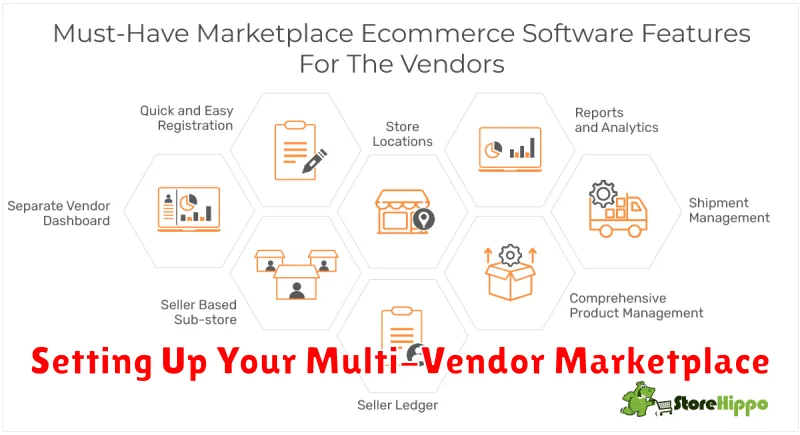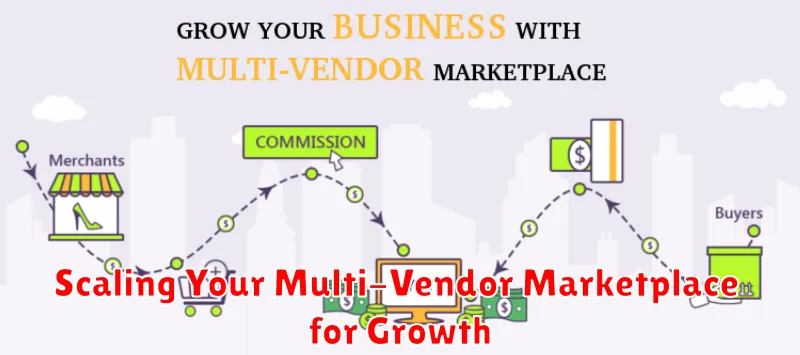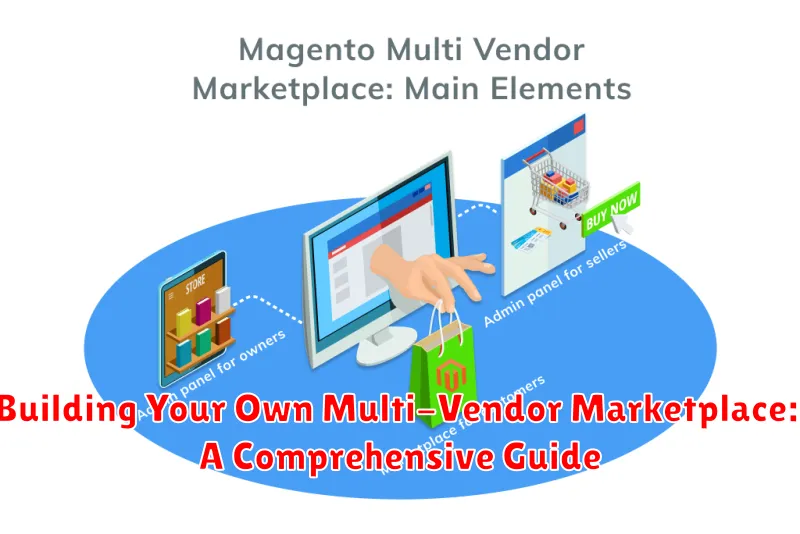Dreaming of creating your own thriving online marketplace like Amazon, Etsy, or Uber? The allure of connecting buyers and sellers and facilitating transactions within a dynamic digital ecosystem is undeniable. This comprehensive guide will equip you with the knowledge and resources necessary to build your own multi-vendor marketplace. We’ll delve into critical aspects of development, including platform selection, design considerations, legal frameworks, and effective marketing strategies. Whether you envision a niche marketplace for handcrafted goods, a platform for freelance services, or a robust multi-vendor e-commerce hub, this guide will provide a roadmap to navigate the complexities of building and launching a successful online business.
Building a multi-vendor marketplace presents unique opportunities and challenges. This guide provides a structured approach, breaking down the process into manageable steps, from initial concept and planning to ongoing maintenance and growth. We’ll cover essential topics such as choosing the right marketplace platform, designing an intuitive user interface, attracting both vendors and customers, managing payments and logistics, and ensuring legal compliance. Learn how to cultivate a thriving online community and establish your multi-vendor marketplace as a trusted destination for buyers and sellers alike. This journey requires dedication and strategic planning, but the rewards of owning and operating a successful online marketplace can be substantial.
Understanding the Multi-Vendor Marketplace Model
A multi-vendor marketplace is an e-commerce platform where multiple third-party vendors list and sell their products or services. Unlike a traditional online store where a single business manages all inventory and fulfillment, the marketplace operator facilitates transactions between buyers and a diverse range of sellers.
The marketplace operator provides the infrastructure, including the website or app, payment processing, and dispute resolution mechanisms. Vendors are responsible for managing their own inventory, setting prices, and often handling shipping directly to the customer. This model allows for a wider product selection and competitive pricing.
Key characteristics of a multi-vendor marketplace include:
- Diverse product offerings: A wider selection compared to single-vendor stores.
- Competitive pricing: Multiple sellers competing for customers.
- Centralized platform: A single platform for buyers to browse and purchase.
- Scalability: Easy to expand product offerings with new vendors.
Key Features of a Successful Multi-Vendor Marketplace
A thriving multi-vendor marketplace hinges on several key features that facilitate smooth operations and attract both vendors and customers. A robust product catalog is essential, allowing for easy navigation and search. Detailed product listings with high-quality images and comprehensive descriptions are crucial for informing purchasing decisions.
Secure payment processing builds trust and ensures smooth transactions for all parties. Offering a variety of payment options caters to a wider customer base. Effective order management streamlines the process from placement to delivery, keeping both vendors and customers informed. Automated order tracking and status updates contribute to a positive customer experience.
Vendor management tools empower vendors to manage their inventory, process orders, and track their sales performance. A transparent commission structure fosters trust and encourages vendor participation. Finally, integrated communication tools facilitate direct communication between vendors and customers, enhancing customer service and resolving issues efficiently.
Choosing the Right Platform for Your Marketplace
Selecting the right platform is crucial for the success of your multi-vendor marketplace. The platform will dictate functionality, scalability, and ultimately, your potential for growth. Consider these key factors when making your decision:
Budget: Platforms range from free, open-source options to premium, enterprise-level solutions. Establish your budget early to narrow down your choices.
Scalability: As your marketplace grows, your platform needs to handle increased traffic and vendor onboarding. Choose a platform that can scale with your business.
Customization: Your marketplace should reflect your unique brand. Consider how much customization each platform offers, from design to functionality.
Features: Essential features include vendor management tools, product catalogs, payment gateways, and order management systems. Prioritize the features most critical to your business needs.
Technical Expertise: Some platforms require extensive technical knowledge, while others offer user-friendly interfaces. Assess your team’s technical capabilities when making a selection.
Setting Up Your Multi-Vendor Marketplace

Setting up your marketplace involves crucial technical and administrative steps. First, choose a domain name that reflects your brand and target audience. Then, secure reliable hosting that can handle anticipated traffic and growth.
Next, configure your chosen platform. This includes installing necessary plugins, customizing the marketplace design, and setting up payment gateways. Ensure secure transactions by integrating with reputable payment processors and implementing robust security measures.
Establish clear vendor onboarding processes. This might involve creating vendor accounts, setting up product listing procedures, and defining commission structures. Create a comprehensive vendor agreement outlining terms and conditions, including payment schedules, product quality standards, and dispute resolution mechanisms.
Finally, thoroughly test all functionalities before launching. This includes testing the checkout process, vendor dashboards, and all integrations to ensure a seamless user experience.
Attracting and Managing Vendors
Attracting and managing vendors is crucial for a thriving multi-vendor marketplace. A robust vendor base ensures a diverse product catalog and a competitive landscape.
Attracting Vendors
Reach out to potential vendors through targeted marketing campaigns. Highlight the benefits of joining your platform, such as access to a larger customer base and reduced marketing costs. Consider offering incentives like discounted commission rates or promotional opportunities.
Managing Vendors
Implement a clear vendor onboarding process with streamlined documentation and training. Establish performance standards and monitor vendor activity regularly. Provide communication channels for feedback and support. A comprehensive vendor management system simplifies these tasks, allowing for efficient communication, performance tracking, and payment processing.
Effectively managing vendor relationships ensures a positive experience for both vendors and customers, contributing to the overall success of your marketplace.
Marketing Your Multi-Vendor Marketplace to Customers
Attracting customers to your multi-vendor marketplace requires a multi-faceted marketing strategy. Focus on building a strong brand identity that resonates with your target audience. Clearly communicate the value proposition of your marketplace, highlighting the variety of products, competitive pricing, and convenient shopping experience.
Digital marketing plays a crucial role. Utilize search engine optimization (SEO) to improve organic visibility. Leverage social media platforms to engage with potential customers and run targeted advertising campaigns. Consider influencer marketing to reach a wider audience.
Email marketing is essential for nurturing leads and retaining existing customers. Develop targeted email campaigns showcasing new products, promotions, and vendor spotlights. Encourage vendors to actively promote their products within their own networks to expand your reach.
Don’t underestimate the power of public relations. Seek opportunities to get featured in relevant publications and industry blogs. Participating in online and offline events can also boost brand awareness and attract new customers.
Ensuring a Smooth Customer Experience
A seamless customer experience is crucial for the success of any multi-vendor marketplace. Prioritize features that simplify the buying process and foster trust.
Streamlined Navigation: Ensure intuitive navigation and search functionality. Customers should be able to easily find products, compare options, and filter results based on their preferences.
Detailed Product Information: Require vendors to provide comprehensive product descriptions, high-quality images, and accurate specifications. This reduces customer inquiries and returns.
Secure Checkout Process: Offer a variety of secure payment options and clearly display security badges. This builds customer confidence and encourages purchases.
Effective Customer Support: Provide multiple channels for customer support, including email, phone, and live chat. Address inquiries promptly and resolve issues efficiently.
Handling Payments and Commissions
A key aspect of managing a multi-vendor marketplace is efficiently handling payments and commissions. Choosing the right payment gateway is crucial. Consider factors like transaction fees, supported currencies, and security measures when selecting a provider.
Establishing a clear commission structure is essential. Determine a percentage or fixed fee for each sale, ensuring it’s fair to both vendors and the marketplace owner. Transparency is key; clearly communicate the commission structure to all vendors.
Automated payment processing simplifies operations. Implement a system that automatically distributes payments to vendors after deducting commissions. This reduces manual effort and ensures timely payouts.
Consider offering multiple payout options to vendors. Providing choices like direct deposit, PayPal, or other digital payment methods can increase vendor satisfaction and streamline the process.
Regularly reconcile payments and commissions to maintain accurate financial records. This helps track revenue, expenses, and vendor earnings, ensuring financial transparency and stability.
Scaling Your Multi-Vendor Marketplace for Growth

Scaling a multi-vendor marketplace requires careful planning and execution. Performance is paramount. As your marketplace grows, ensure your platform can handle increased traffic and transactions without performance degradation. Invest in robust infrastructure that can scale horizontally.
Vendor management becomes increasingly complex with scale. Streamline vendor onboarding, communication, and performance monitoring. Develop clear performance metrics and provide vendors with the tools they need to succeed.
Customer acquisition cost (CAC) should be closely monitored. As you scale, explore efficient marketing strategies to reach new customers while maintaining a reasonable CAC. Consider targeted advertising and strategic partnerships.
Expand product categories or services strategically. Analyze market trends and identify opportunities to broaden your offerings. Diversification can attract new customer segments and drive further growth.
Finally, automation is key. Automate processes like vendor payouts, customer support interactions, and inventory management to improve efficiency and free up resources for strategic initiatives.

